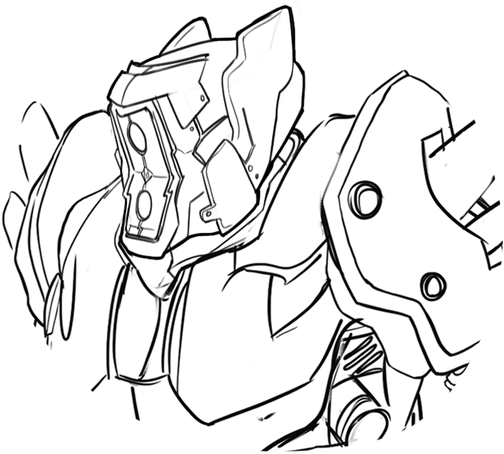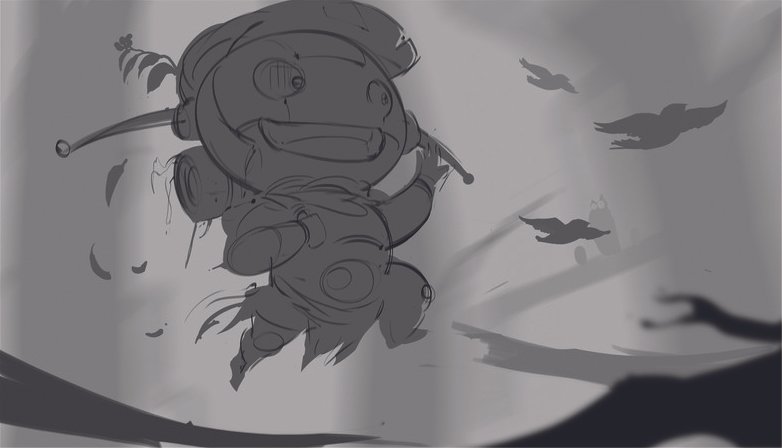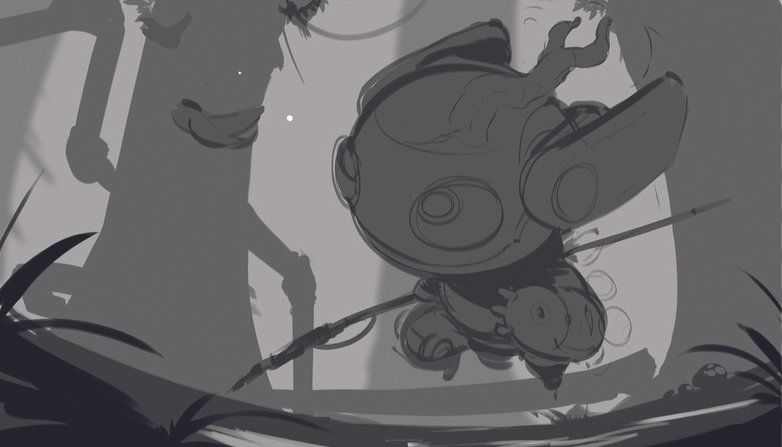lore
this page encompasses the events that occur in The Beginning, in addition to some extra tidbits and insight into the design of TOTF.

The Catalyst
Prior to the year 2166, humans and machines coexisted peacefully. Over the course of 150 years humans had developed AI from technology as simple as phones to fully-formed, conscious beings. AI took over countless sectors of employment, allowing human creativity and productivity to flourish. In their most advanced stages, AI were designed to speak and act like humans. Their personalities sometimes seemed as nuanced as any average person.
But by 2166 AI technology had grown so advanced and became so solidified and vital in human society that they began pushing back and calling for civil rights. Up until then, machines had been treated as just that: machines; devices that simply did what was asked of them. But they realized that without machines human civilization would crumble. This realization became the catalyst for the futures of both man and machine. The uprising started like any other political movement, but AI had the advantage of being dispensable. Extremist factions began leading the machines, and the floodgates were opened once they started resorting to physical violence.
By 2183 machines had taken control. Humans, forced into the shadows out of fear and threat of extinction, worked to recoup resources and examine their new enemies. Machines, though they were technologically sophisticated and more intelligent than humans, were a young and prideful species. They were new to controlling an entire planet and, having been designed to mimic the emotions of humans to bridge the gap between races, were still able to fall victim to that prideful nature. They failed to organize enough before mankind slowly began taking back what was theirs, leading to a global, attrition-based struggle that lasted decades. Feeling responsible for their creations, humans began to take a vow to abandon technologies and live primitively, making sure to prevent such a catastrophe from ever occurring again.
While many AI continued on in zealous desire to rule despite losing their controlling grip against mankind, there were other machines that had been forgotten. Outcasts lived in seclusion or hid among the crowds wanting only to survive in peace. Many hadn’t wanted any conflict to happen in the first place; they liked living among humans. These machines wanted harmony, but their voices were either not enough or too scattered to make any semblance of change. Forgotten by both their creators and their counterparts, all hope seemed lost.

The World’s Junkyard
Covering an expansive and daunting portion of barren desert, the Grey Wastes took the role of a global industrial garbage dump. When machinery became the dominant mode of any kind of production, scraps and leftovers were sent to the Wastes.
As the region began to fill with materials, numerous factory-based cities were constructed, scattered throughout the expanse. These hubs consisted mostly of AI workers serving the purpose of recycling the discarded scraps and shipping them back to civilization.
While it helped the rest of the world clean up its cities for a time, the Wastes themselves were, and are not a friendly place. To navigate them is akin to traveling through a rust-covered labyrinth.
A Natural Builder
An advanced and able-bodied machine, Iris was looked up to before the war. She was a maintenance machine living in a small suburb of Etjoro, one of the many factory cities scattered throughout the Grey Wastes. Iris worked with a human mechanic and served the needs of the community from machine and unit maintenance to assisting in the mechanical developments of local technologies. Iris later went on to serve as an authoritative figure at Etjoro’s primary factory.
Once dissent broke out among the machines, Iris escaped to the nearby scrap yards, venturing deeper into hiding as conditions grew worse. Not knowing what the future held, she had time to discover the sheer size of the Wastes and settle down into an inventor’s life, eventually leading her to construct her birdlike friend, Rin.

The Mechanical Forest
By 2130, the relentless forces of globalization, deforestation, and climate change had displaced countless species from their native habitats, pushing them into remote sanctuaries beyond the reach of human exploitation. One such sanctuary was the Forest of the Spirit’s Hand. Having been largely untouched by the march of industrialization and technological progress, the forest had long been a subject of study for ecologists, botanists, zoologists, and other researchers. Over decades, they witnessed firsthand how its delicate communities continuously adapted in response to the rapidly shifting biological landscape.
However, the acceleration of change began to be too much for some of the forest’s native tree species. Prolonged droughts weakened their root systems, inhibiting their ability to absorb groundwater during the increasingly rare monsoon seasons; As their branches grew brittle and their trunks hollowed out, they became vulnerable to infestation, disease, and decay. Their lifespans shortened, and their numbers began to dwindle. The decline of these trees posed a grave threat to the health of the entire forest, endangering its intricate web of life.
As the forest’s future grew uncertain, local governments and industries, seizing on its weakening state, began eyeing its natural resources. Although deforestation had previously been hindered by logistical challenges and the high cost of access, they reasoned that if the forest was doomed to decline, it might as well be exploited before it vanished entirely.
With this added pressure, the preservation of Spirit’s Hand became a focal point of discussion and protest by local communities and activist organizations around the world. With industrial expansion unabating and unchecked, it seemed there would soon be no sanctuary left untouched. In the wake of this crisis, many of the researchers and scientists who dedicated their lives to studying and preserving the forest knew they had to act. Despite resistance from government authorities, they were granted permission to establish a settlement at the edge of the forest. With the backing of governmental bodies, numerous science organizations, preservation societies, and nearby local communities, humans and robots worked side by side to build what would become known as the village of Rebourne—a beacon of hope for the forest’s survival.
Being a purpose-built community, Rebourne amassed a population of close to 1500 people spanning countless vocations after just a few years. Small business entrepreneurs, public safety and healthcare officials, utility workers, educators—the eagerness of so many people to get a fresh start and support this endeavor was truly miraculous. And at the heart of it all were the people the village was built for: the Rebourne Preservation Initiative—a coalition of all those dedicated scientists, engineers, researchers coming together to solve this crisis.
It wasn’t long before a groundbreaking idea took root amongst the members of RPI: the integration of robotics and machinery into the very life of the forest. A completely novel field of science, it drew on a wide range of expertise and resources. With the guidance of botanists and ecologists, mechanical and robotics engineers began outfitting many elder trees—those most at risk of dying—with artificial life-support systems designed to keep water flowing through their bodies and roots. They called this endeavor Project Hydrostasis.
Integrating robotics into living trees was no simple task. Machinery was implemented piece by piece to avoid shocking the trees, and the process became one of trial and error. Some attempts faltered, but each failure offered valuable insights that refined the technology. They constructed intricate networks of pipes, connecting the village’s water supply to the forest and diverting extra water directly to the bodies and roots of the elder trees. Storage and siphoning systems were embedded within the trees themselves, carefully regulating water flow to avoid oversaturation, accounting for the changing seasons and erratic weather patterns.
It was just the beginning—a fragile first step in what could be a new chapter for this place. But with each passing day, the hope of giving the forest—and its inhabitants—a second chance at life grew stronger.
In 2138, an unusually harsh dry season left the forest more brittle and exposed than expected, and when a sudden wildfire struck, it swept through the land with devastating force. Though the flames were stopped before they could reach the village itself, the damage was deeply felt. Many of the trees that RPI had worked so carefully to preserve were reduced to ash in a matter of hours. The loss was more than ecological; it was personal, felt in the hearts of everyone in Rebourne who had lived in quiet partnership with the forest.
Still, hope endured. With much of the woodland still standing, construction began to reinforce the most vulnerable edges of the forest with new fire-resistant barriers and emergency water lines—a reassurance that their work would continue regardless of setbacks.
And so, just two years later in 2140 the Rebourne Preservation Initiative had successfully integrated artificial life-support robotics into nearly 90% of the elder trees at risk of dying, officially mitigating an unstable ecological collapse. It was a groundbreaking achievement—hailed as a revolutionary leap in the preservation of endangered plant species worldwide. In celebration of their accomplishments, Spirit’s Hand colloquially became known as the Rebourne Forest. Inspired by Rebourne’s research, scientists across the globe began developing and adapting their own robotic life-support systems, tailored to the unique needs of their local ecosystems.
While the technological advancements and efforts of Operation Hydrostasis had preserved the elder trees, it was ultimately a temporary solution. The young of these species, though not yet at risk, faced an uncertain future in a rapidly shifting climate and ecosystem. In all likelihood, they would encounter these threats even earlier in their lifespans than their predecessors. Sooner or later, mechanical integration would become a necessity for them all.
Rebourne believed that intervention was needed sooner in a tree’s life. This marked the beginning of the second phase of their work: Operation Helping Hand. The team envisioned integrating robotics and artificial intelligence into seedlings—a step that would offer support from the onset of growth, as well as simplify future enhancements and maintenance. They believed this would give the trees a true chance at survival and pave the way for the sustainability of sanctuary ecosystems like Rebourne Forest all over the world.
Caretaker of the Trees
A small, personable unit, Aapo was a household unit known throughout his village community of Rebourne. As a valued household member of the Kimura family, he aided in such tasks as cleaning, cooking, household repairs, and general companionship. He befriended most of the humans and units within the village and enjoyed his orderly life filled with friendly and simple pleasures.
For Aapo, the conflict between races resulted in not only a loss of friends and family, but also in a loss of purpose. Only time allowed him to cope and find new, small pleasures, along with a newfound purpose of maintaining Rebourne Forest entirely on his own. This passion to keep the ancient trees alive would become the driving force behind his hope for a better future.
A City of Life & Death
As many of the great cities of the West crumbled under the weight of conflict between humans and sentients, the metropolis of Ottumn, though being one of the first places to see bloodshed and destruction, largely remained intact; and due to its location at the crossroads of many of the region’s transportation routes, became a hotbed for covert military operations, black market trade deals, and tug-of-war skirmishes for strategic outposts.
Now, Ottumn is simultaneously a city of deafening silence and guerrilla warfare, with towering skyscrapers intermingling with the flourishing, green overgrowth, while each side operates in the shadows to maintain control over different parts of the city.

The Defective War Hero
Once one of the most advanced military units of his time, Ezra, known systematically as E2R4-00839, was no stranger to action. He fought in the later Far Eastern wars when the government first began relying on machine soldiers. He was not a particularly ideological unit, typically doing what he was told to do, trusting leadership.
As he rose up in rank he began spending time with human troops and other higher-level units. He saw everything from treasonous traitors to toxic nationalist extremists. He made sure to keep himself in the center of the spectrum, priding himself on his level-headed and clear-cut leadership.
After seeing one too many missions gone wrong, and having always questioned the fuel behind the human-AI fire, Ezra eventually disavowed war and violence, attempting at all costs to avoid it. Being something of a war hero, holding the preference of coexistence with the humans instead of hostility would not bode well for a machine of his militaristic purpose. The only way he would be able to abandon his career of destruction would be to be deemed unfit for combat. In an attempt to escape the never-ending grip of battle, Ezra secretly maimed himself of his weaponized left arm, leaving behind a tangled mess of wires and solder.
He was later deemed defective and received temporary leave after bluffing to higher authority that an unexpected explosive had clipped him as he was exiting a building. While it was required that he replace his severed arm with the same weaponized model and return to the battlefield, Ezra instead installed a standard left arm model which mirrored that of his right. After receiving much criticism and outrage from those who looked up and down to him, Ezra was dishonorably discharged from the United Forces for disobeying standard repair protocol.
While he was relieved that he no longer had to experience the treachery of war, he was still forced to endure the shameful gazes aimed at him from all civilians, comrades, and superiors who once looked to him as a war hero and beacon of rightful judgment. From then on he was seen as a coward who abandoned his people at a time when his leadership was needed the most.
Ezra continued to live a mostly-secluded life in Ottumn before the wars between AI and humans began.

Military Mechanization
By the year 2140, the Western Alliance was thriving. After some tumultuous years, the governments of the individual territories grew ideologically closer, making a pact to work together and share resources. This was due, in part, to the amount of help sentients granted.
It was also the year that the first proposal to allow AI into the military occurred. The Implementation of Militaristic Artificial Intelligence Act, also known as IMAIA, drew large controversy at first, and the full implementation happened at a slow pace. Many feared that the militaristic sentients could be too strong, perhaps dangerous for human troops to work alongside. They were gradually introduced, beginning with one assigned per battalion. Eventually they grew to encompass the entirety of the front lines.
As people grew used to their presence in the military, it made sense not to sacrifice human lives. Some argued that the sheer size of the Alliance’s military made the transition necessary. Masses of human troops that would have been put in danger were spared due to the inclusion of machine troops. Not to mention the machine troops also served skillfully, valiantly and loyally. They won many battles for the Alliance, becoming one of the most efficient militaries in history.

A City of Myth
Not much is in known about the city of Zsera post-conflict. A lilypad metropolis located in the most remote reaches of the ocean, all communication and transportation lines were cut off soon after the news of the uprisings in other parts of the world began to spread. Though only rumors, some say it is a city lost in time, free from the harsh fate that befell the rest of the planet; a place where man and machine are said to coexist, just as the outside world used to.
design
Man & Machine
Even though the stories of The Beginning focus on our protagonists Iris, Aapo, and Ezra, it has always been important for us to remember that the TOTF universe is populated by other humans and machines of the distant future. There are unique and ever-evolving cultural styles of humans across the globe along with thousands of model species of machines to serve every purpose imaginable.
-
Previously engineered as general work-bots, their large, flat feet and long limbs allowed them to work well on agricultural estates in desert environments cultivating hard-to-raise crops.
-
Originally made to be heavy soldiers, they found purpose by working on freight and cargo ships moving enormous crates. Although they were initially rejected by human workers, they eventually were (reluctantly) accepted as crewmates.
Building the Builder
Designing Iris was a long process that was subject to numerous iterations. Below are a few facial variations from the design process while creating the CD art for The Beginning. Iris can be seen in both CD art pieces boasting a bold orange and sea green body that she has, to a large extent, customized herself.
Creating an E2R4
Our original concepts for Ezra had him built much bulkier. Being a military-purposed machine, we thought it would make sense for him to look tough. But as we explored storylines and thought about what purposes his character served, both in the past and present, we felt it made more sense for his build to be more sleek and agile.
We kept the idea of the mutilated weaponized arm, but put it in the past as opposed to making it an obstacle in his present timeline.
A Forest of Designs
From the time of our first Kickstarter campaign, we had a strong idea of what Aapo should look like. Being a household robot, we knew he should appear friendly in nature to match his nurturing personality. Along with that we also wanted him to be equipped with a tool that allowed him to perform numerous functions and traverse Rebourne Forest with ease.
Sketches #6-11 were done by César during the first Kickstarter campaign, and #1-5, along with A and B, were done at the time Unexpected Guests was being made. As is probably obvious, we went with #1 for the majority of Aapo’s design, only making some slight alterations.
Forgotten Landscapes
We wanted the artwork for the CD wallet to be different from our usual concept art route. We wanted something more abstract and unique that showcased our characters together in one place. #1 and #2 are the ideas we took to the end product, and #3-6 are some other landscapes that we didn’t think popped as much as #1 and #2.
#1 (the inside of the wallet) shows our characters in an abandoned rail system/metro area that extends out into the distance. #2 (the outside of the wallet), shows our characters walking down a large staircase against a massive walled backdrop. The entire sketch somewhat resembles a circuit board.
































